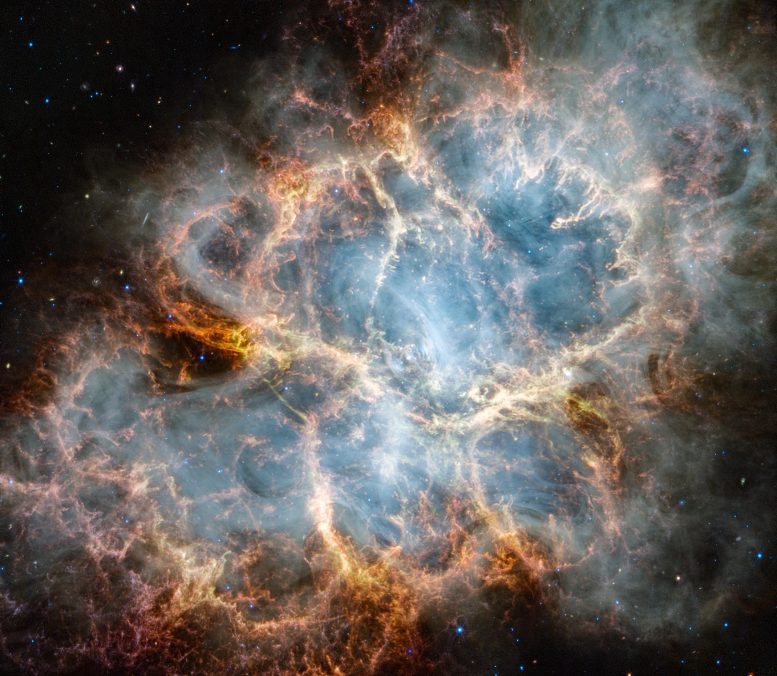
NASA’s James Webb Space Telescope has gazed at the Crab Nebula in the search for answers about the supernova remnant’s origins. This image by Webb’s NIRCam (Near-Infrared Camera) and MIRI (Mid-Infrared Instrument) reveals new details in infrared light. The supernova remnant is comprised of several different components, including doubly ionized sulfur (represented in red-orange), ionized iron (blue), dust (yellow-white and green), and synchrotron emission (white). In this image, colors were assigned to different filters from Webb’s NIRCam and MIRI: blue (F162M), light blue (F480M), cyan (F560W), green (F1130W), orange (F1800W), and red (F2100W). Credit: NASA, ESA, CSA, STScI, Tea Temim (Princeton University)
Exquisite, never-before-seen details help unravel the supernova remnant’s puzzling history.
Although the Crab Nebula is one of the most well-studied supernova remnants, questions about its progenitor and the nature of the explosion that created it still remain unanswered. NASA’s James Webb Space Telescope is on the case as it sleuths for any clues that remain within the supernova remnant. Webb’s infrared sensitivity and spatial resolution are offering astronomers a more comprehensive understanding of the still-expanding scene.
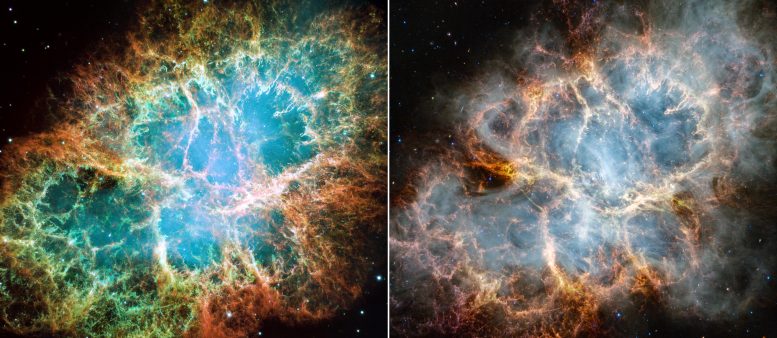
A side-by-side comparison of the Crab Nebula as seen by the Hubble Space Telescope in optical light (left) and the James Webb Space Telescope in infrared light (right). The Hubble image was released in 2005, while astronomers have recently used Webb’s NIRCam (Near-Infrared Camera) and MIRI (Mid-Infrared Instrument) to reveal new details of the Crab Nebula. By studying the recently collected Webb data, and consulting previous observations of the Crab taken by other telescopes like Hubble, astronomers can build a more comprehensive understanding of this mysterious supernova remnant. Credit: Hubble Image: NASA, ESA, J. Hester, A. Loll (Arizona State University); Webb Image: NASA, ESA, CSA, STScI, T. Temim (Princeton University)
The Crab Nebula Seen in New Light by NASA’s Webb Space Telescope
NASA’s James Webb Space Telescope has gazed at the Crab Nebula, a supernova remnant located 6,500 light-years away in the constellation Taurus. Since the recording of this energetic event in 1054 CE by 11th-century astronomers, the Crab Nebula has continued to draw attention and additional study as scientists seek to understand the conditions, behavior, and after-effects of supernovae through a thorough study of the Crab, a relatively nearby example.
Seeking Answers About the Crab Nebula
Using Webb’s NIRCam (Near-Infrared Camera) and MIRI (Mid-Infrared Instrument), a team led by Tea Temim at Princeton University is searching for answers about the Crab Nebula’s origins.
“Webb’s sensitivity and spatial resolution allow us to accurately determine the composition of the ejected material, particularly the content of iron and nickel, which may reveal what type of explosion produced the Crab Nebula,” explained Temim.
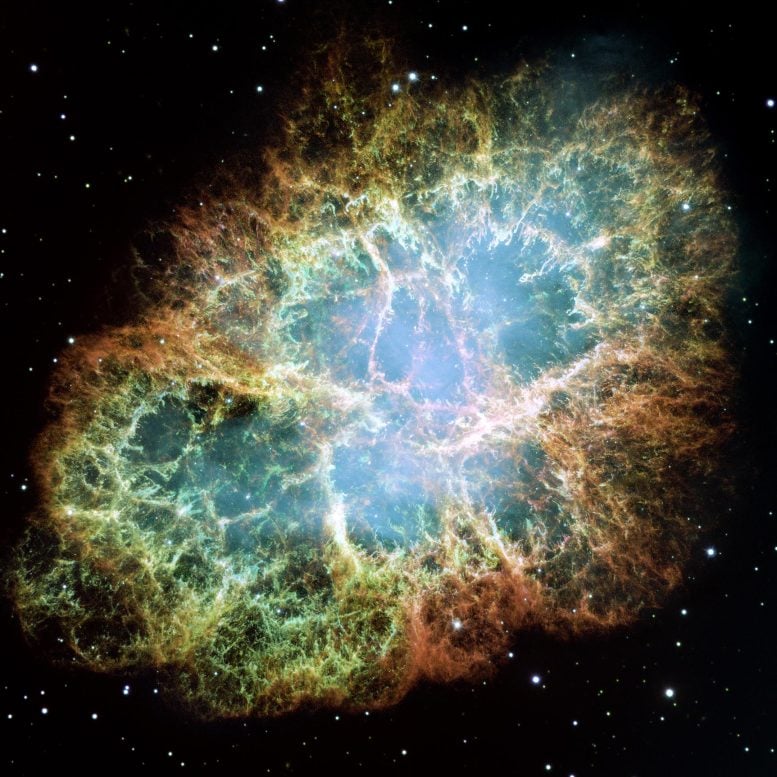
At the time it was captured, this Hubble image was the most detailed view of the entire Crab Nebula ever. The Crab is among the most interesting and well-studied objects in astronomy. The Crab Nebula is an expanding remnant of a star’s supernova explosion. Japanese and Chinese astronomers recorded this violent event nearly 1,000 years ago in 1054 AD, as did likely the Native Americans. The glowing relic has been expanding since the star exploded, and it is now approximately 11 light-years in width. Credit: NASA, ESA, and Allison Loll/Jeff Hester (Arizona State University). Acknowledgment: Davide De Martin (ESA/Hubble)
Comparing Observations
At first glance, the general shape of the supernova remnant is similar to the optical wavelength image released in 2005 from NASA’s Hubble Space Telescope (see image above). In Webb’s infrared observation, a crisp, cage-like structure of fluffy gaseous filaments are shown in red-orange. However, in the central regions, emission from dust grains (yellow-white and green) is mapped out by Webb for the first time.
Additional aspects of the inner workings of the Crab Nebula become more prominent and are seen in greater detail in the infrared light captured by Webb. In particular, Webb highlights what is known as synchrotron radiation: emission produced from charged particles, like electrons, moving around magnetic field lines at relativistic speeds. The radiation appears here as milky smoke-like material throughout the majority of the Crab Nebula’s interior.
This video tours the Crab Nebula, a supernova remnant that lies 6,500 light-years away in the constellation Taurus. Despite this distance from Earth, the Crab Nebula is a relatively close example of what remains after the explosive death of a massive star.
Pulsar Heart and Its Influence
This feature is a product of the nebula’s pulsar, a rapidly rotating neutron star. The pulsar’s strong magnetic field accelerates particles to extremely high speeds and causes them to emit radiation as they wind around magnetic field lines. Though emitted across the electromagnetic spectrum, the synchrotron radiation is seen in unprecedented detail with Webb’s NIRCam instrument.
To locate the Crab Nebula’s pulsar heart, trace the wisps that follow a circular ripple-like pattern in the middle to the bright white dot in the center. Farther out from the core, follow the thin white ribbons of the radiation. The curvy wisps are closely grouped together, outlining the structure of the pulsar’s magnetic field, which sculpts and shapes the nebula.
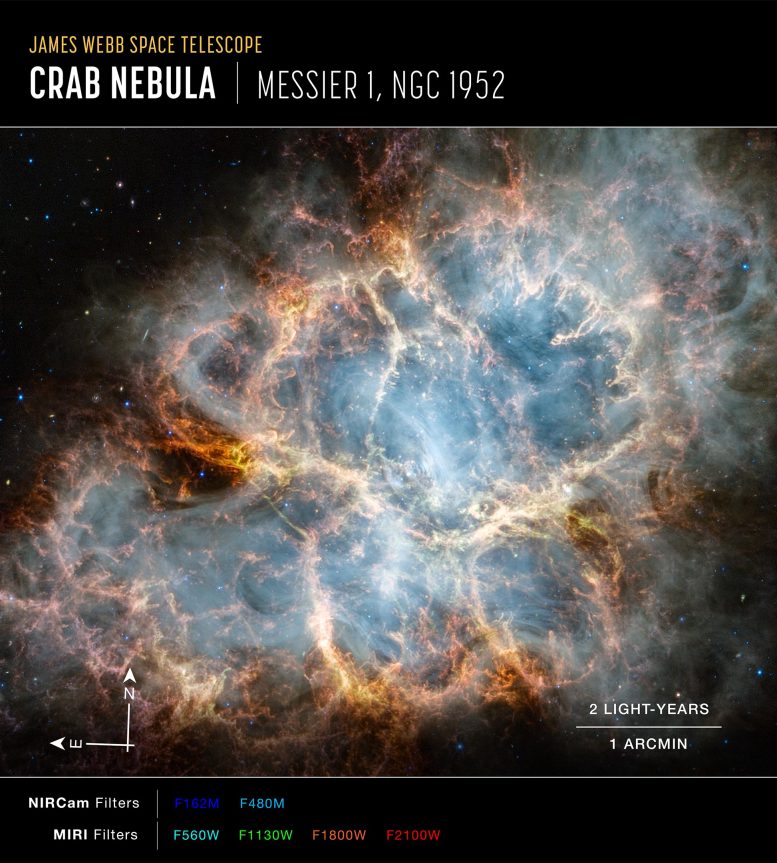
Image of the Crab Nebula captured by Webb’s NIRCam and MIRI, with compass arrows, scale bar, and color key for reference.
The north and east compass arrows show the orientation of the image on the sky. Note that the relationship between north and east on the sky (as seen from below) is flipped relative to direction arrows on a map of the ground (as seen from above).
The scale bar is labeled in light-years, which is the distance that light travels in one Earth-year. (It takes 2 years for light to travel a distance equal to the length of the bar.) One light-year is equal to about 5.88 trillion miles or 9.46 trillion kilometers. The field of view shown in this image is approximately 10 light-years across.
This image shows invisible near-infrared and mid-infrared wavelengths of light that have been translated into visible-light colors. The color key shows which NIRCam and MIRI filters were used when collecting the light. The color of each filter name is the visible light color used to represent the infrared light that passes through that filter.
Credit: NASA, ESA, CSA, STScI, Tea Temim (Princeton University)
At center left and right, the white material curves sharply inward from the filamentary dust cage’s edges and goes toward the neutron star’s location, as if the waist of the nebula is pinched. This abrupt slimming may be caused by the confinement of the supernova wind’s expansion by a belt of dense gas.
The wind produced by the pulsar heart continues to push the shell of gas and dust outward at a rapid pace. Among the remnant’s interior, yellow-white and green mottled filaments form large-scale loop-like structures, which represent areas where dust grains reside.
Future Analysis and Comparisons
The search for answers about the Crab Nebula’s past continues as astronomers further analyze the Webb data and consult previous observations of the remnant taken by other telescopes. Scientists will have newer Hubble data to review within the next year or so from the telescope’s reimaging of the supernova remnant. This will mark Hubble’s first look at emission lines from the Crab Nebula in over 20 years, and will enable astronomers to more accurately compare Webb and Hubble’s findings.
Want to learn more? Through NASA’s Universe of Learning, part of NASA’s Science Activation program, explore images of the Crab Nebula from other telescopes, a 3D visualization, data sonification, and hands-on activities. These resources and more information about supernova remnants and star lifecycles can be found at NASA’s Universe of Learning.
The James Webb Space Telescope is the world’s premier space science observatory. Webb is solving mysteries in our solar system, looking beyond to distant worlds around other stars, and probing the mysterious structures and origins of our universe and our place in it. Webb is an international program led by NASA with its partners, ESA (European Space Agency) and the Canadian Space Agency.
NASA’s Universe of Learning materials are based upon work supported by NASA under cooperative agreement award number NNX16AC65A to the Space Telescope Science Institute, working in partnership with Caltech/IPAC, Center for Astrophysics | Harvard & Smithsonian, and Jet Propulsion Laboratory.

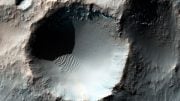
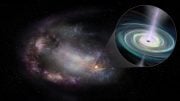






Be the first to comment on "Crab Nebula’s Puzzling Mysteries Unveiled by NASA’s James Webb Space Telescope"